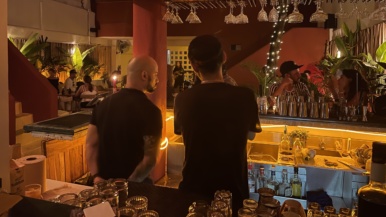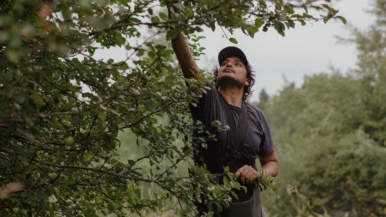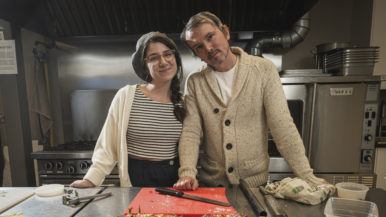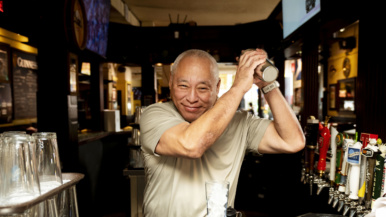When I was 18, I went on a vision quest that changed my life

I was seven years old the first time I experienced First Nations culture. My family went to the Guelph penitentiary, where two of my relatives were in jail. That day, the prison was holding a gathering for Indigenous inmates. It was the first time I heard a drum circle, and the sound was deep and powerful. But when I started to dance, my cousins made fun of me. I went back to pretending I wasn’t interested.
I didn’t have a happy childhood. My Cree father, a residential-school survivor, and my Ojibwa-Anishinabe mother split when I was three and sent me to live with my grandparents. I slept on a cot in their living room, and my little brother’s crib was in the hallway. When I was 10, I moved back in with my mom in a subsidized housing complex at Pape and Danforth. We argued all the time. A few months later, I reconnected with my dad, who was living in Sault Ste. Marie. When I was 14, after a particularly nasty fight with my mom, I hopped on a Greyhound bus and went to stay with my dad and his girlfriend. That didn’t work out, so they put me up in a tiny one-bedroom apartment and bought me groceries once a week. Soon I was drinking and smoking weed. I was arrested several times—for stealing, for fighting, for selling drugs—and spent four months in juvie. Eventually, I was remanded back into my mother’s custody. I wasn’t thrilled about it, but I knew she’d let me do what I wanted.
When I moved back to Toronto at age 15, my grandparents insisted that I prepare for my confirmation at St. Ann’s Catholic Church near Gerrard and Broadview, where they were parishioners. The church has a Native People’s Parish, which combines Catholicism with elements of Indigenous spirituality. The church leaders incorporate sage-burning ceremonies into Mass, for instance, and translate hymns into Indigenous languages. As part of my confirmation, the priest insisted that I go on a vision quest—a ritual that lasts anywhere from 24 hours to a week. You’re left alone in the wilderness without food or supplies, and you pray to the Creator for guidance and wisdom.
On the night of my vision quest, I set up my tent at Dreamer’s Rock, a sacred place on Manitoulin Island. I was skeptical. I just thought I’d be abandoned outside, bored, hungry and alone. To my shock, I had a vision that night. It was an old man, standing beyond my tent. He looked like he was beckoning me. I didn’t recognize him, but I believe he was a manifestation of First Nations culture—my culture—which was waiting for me to embrace it.
Over the next few years, I dove into my Indigenous heritage. I read about Crazy Horse, Tecumseh and Sitting Bull. I joined a drum circle that met regularly at the Native Canadian Centre. I learned about oppression and how these rituals provided camaraderie and kinship.
By the time I was 18, I was entirely estranged from my family. I was living in a studio apartment at Broadview and Danforth, and working as a dishwasher at the Native Canadian Centre. I was poor, isolated and depressed. Around that time, I went on my second vision quest, this one in Red Lake, Minnesota. It was a powerful experience. I was left out in the bush alone, 10 miles away from the camp, for three days. I had no food or water. I just had to sit up in a tree on some scaffolding and pray. It wasn’t the fasting, bears or wolves I was afraid of; it was being alone with my demons that terrified me.
That first night, I yelled, I screamed, I cried and I sang. I prayed to the Creator and asked what my purpose was. I reflected on my mistakes and realized my childhood had wired me to believe that I was worthless, that I could never accomplish anything. Even though I was only there for three days, it felt like forever. The day after, I went to the sweat lodge. There was a conductor there to make sure I was safe, but, otherwise, it was just me and the fire. I stood in front of the flames and told the spirits my story. I prayed and I suffered. It was an intense, cathartic experience.
That vision quest saved my life. When I returned from it, I found a new sense of belonging in the Indigenous culture I had discovered. I became an active member of the community, serving as the vice-president of the National Aboriginal Youth Council until I was 25. I also started singing and performing at powwows and Native ceremonies in Ontario and across Canada. And I continued to do vision quests every spring and fall.
My life is richer than I ever imagined. Ten years ago, I met my wife, Erika. Today, we have three children: our son is five and our twins are one and a half. Last year, I was the head dancer at a powwow up in Sudbury, and the dance group and I officially invited my son to join us during the ceremonies. It’s one of the greatest joys of my life that my children will have unfettered access to something I spent years searching for.
Eddy Robinson is a musician, artist and educator.
Email submissions to memoir@torontolife.com





